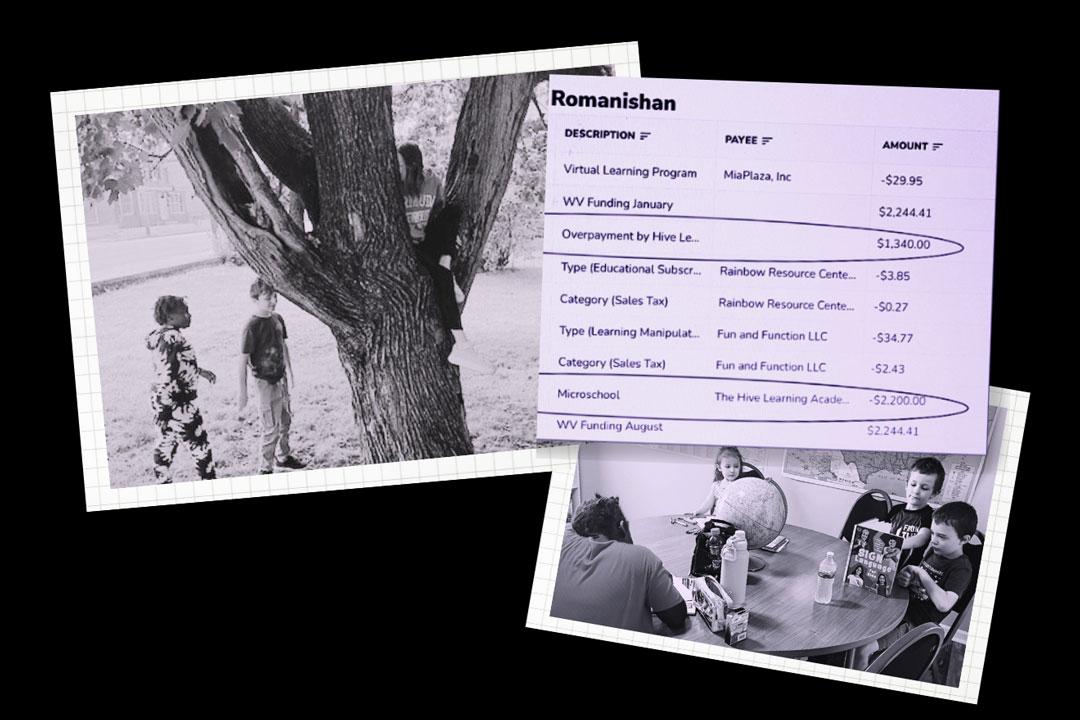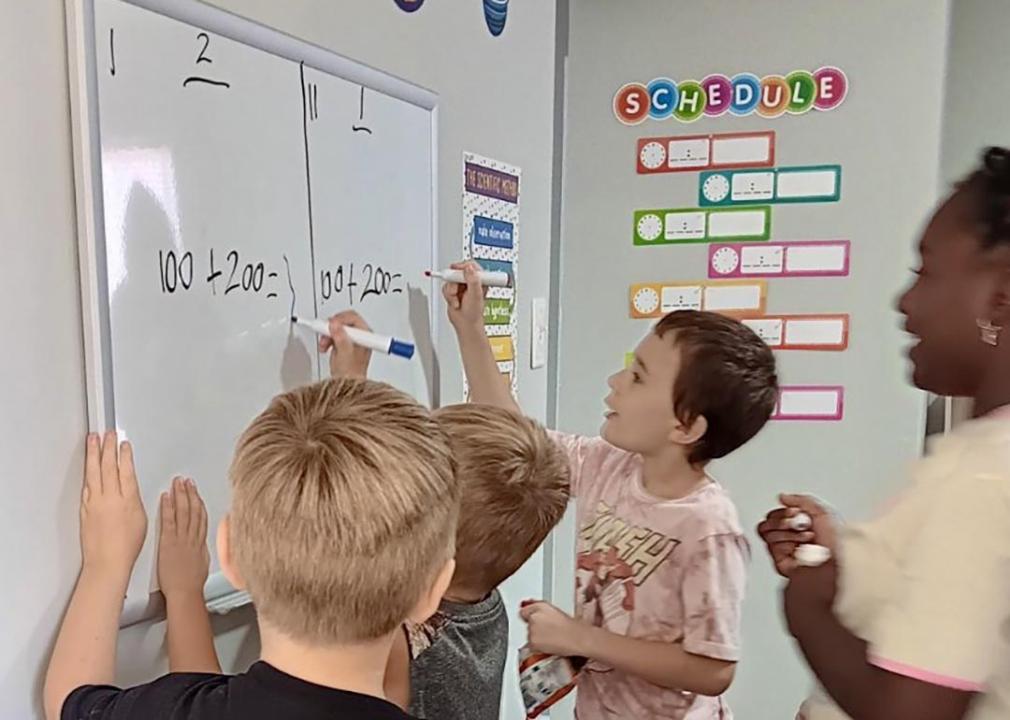Failed West Virginia microschool fuels state probe — and some soul-searching

The 74
Failed West Virginia microschool fuels state probe — and some soul-searching
photo illustration showing students from microschool and receipt of payments
In August, Kelly Romanishan thought she’d found the right school for her son — an innovative startup in a rented two-story house that promised STEM lessons, art activities and “the necessary tools to take on the world.” The West Virginia mom paid the operator a $2,200 advance from her Hope Scholarship — an ESA, or education savings account, that gives families state funds for tuition or homeschooling expenses.
But as The 74 reports, events at The Hive Learning Academy quickly unraveled. Instead of structured meal times, children just grabbed lunch from the refrigerator when they got hungry. Her son “would come home starving because he was too shy to just go into someone else’s fridge,” Romanishan said.
Kathy Dailey, who enrolled her 13-year-old son there, had a similar experience. When she visited the school in the eastern panhandle town of Martinsburg, students were just “hanging out,” buried in their phones.
An exasperated Romanishan said she “soon realized that The Hive was actually just a glorified babysitter.”
By Christmas, they’d joined several parents demanding their money back and scrambling to find other arrangements — inquiries that prompted Republican state Treasurer Riley Moore to include the school in an “ongoing audit and investigation,” an official said.
The probe is believed to be the first government investigation anywhere into a self-identified microschool, providing an awkward milestone for a movement that mushroomed during the pandemic and now includes 125,000 schools nationwide, according to the National Microschooling Center.
Hailed by Republicans, and fueled by the spread of ESAs, microschools operate out of homes, storefronts and churches with a degree of freedom from government oversight. But the West Virginia episode shows that managing that freedom while maintaining public accountability can be a tricky balancing act, even for the movement’s fiercest advocates.
“We’re in a transitional market,” said Jamie Buckland, who runs West Virginia Families United for Education, a nonprofit that advises both parents and vendors in the sector. She thinks states with ESAs should do a better job preparing school founders and helping families navigate their options.
“If we don’t want the government to provide the guardrails and the parameters,” she asked, “what is our movement doing to provide our own guardrails?”
Acknowledging they’d received “allegations of specific Hope Scholarship violations,” the treasurer’s office, which runs the ESA program, would not comment on the scope of the investigation or when it would be completed. In a November email shared with The 74, an assistant treasurer told Romanishan the office was considering the “potential involvement of law enforcement if appropriate,” but has yet to bring charges.
In an interview with The 74, Hive founder Kaela Zimmerman explained that she lacked the cash flow to make the venture work and struggled to get answers from the state when the program collapsed. She said she has since repaid the state over $15,000 in Hope funds.
Romanishan called the experience “not only painful, but disruptive.”
“It makes it hard to trust anyone else, which is sad because the area needs a good microschool,” she said.
![]()

Kaela Zimmerman
‘We tried our best’
students at microschool
Zimmerman thought so, too. The homeschooling mother opened The Hive with co-founder Kristin Volpe to give her own three children more opportunities to make friends. She rented the space, hung maps on the walls and culled curriculum materials from her favorite homeschooling programs.
When 30 families registered last summer, she had high expectations. To help get started, she asked parents in August to pay the bulk of their tuition up front — roughly $2,000 to $4,000 per student. But she had to dip into her own money to pay for furniture and supplies, and when fall came, only eight students showed up.
She said she and Volpe never intended to “avoid our responsibilities.” With far less revenue than expected, they didn’t have enough to cover costs and pay themselves. To save money, Zimmerman moved out of the home she was renting and into the second floor of the microschool location. She and Volpe took jobs at a Macy’s warehouse to pay bills and Zimmerman began bartending a few nights a week.
But juggling multiple jobs made for a “hit or miss schedule” for students, Dailey said.
“It was a fun environment,” she added. “But there wasn’t any homework or a set curriculum.” The state doesn’t ask potential vendors to submit a business or education plan up front. Anyone who wants to be an authorized Hope “service provider,” including a microschool, must sign a contract agreeing to get criminal background checks on staff working with students and to notify districts when they enroll. To receive funds, vendors need only submit a W-9, a tax form for an independent contractor, and document the Hope funds they receive from parents.
Their downfall, Zimmerman said, was a lack of startup cash. She applied for a grant from the Vela Education Fund, a foundation-funded initiative that has helped launch and expand microschools and other alternative education programs. But they turned her down, saying that they had received more applications than they could fund.
When she realized she couldn’t keep the program going, Zimmerman said she asked state officials how to return the ESA funds, but didn’t receive a lot of guidance. That’s why a November certified letter threatening criminal charges caught her off guard. She said she has since returned over $15,000, covering all of the scholarship funds she received minus payment for days students attended.
“It was very stressful and upsetting for us,” she said. “We are just two working-class mothers with a great idea, but no means to make it happen. We tried our best.”
‘The chances of failure are very high’
But it takes more than good intentions to run a quality program, said Rachelle Noble, founder of Microschool Solutions, an Arizona-based consulting firm that advises aspiring school leaders.
Formerly with Prenda, a microschool network, Noble was in charge of the model’s growth. Two years ago, she made what she describes as a tough decision to close two programs that operated with a Kansas school district’s virtual program. Both schools served families in low-income neighborhoods near Wichita.
“We did it way too late,” she said. The environment wasn’t dangerous, she said, but “it got to the point where it was clear that it was educational neglect.” The schools, she said, lacked an “emphasis on academics.”
The reality is that many new microschools don’t last beyond the first year, said Amar Kumar, CEO of KaiPod Learning, another microschool network. Before he accepts prospective founders into the organization’s “catalyst” program, he ensures they have a solid financial plan.
“It’s the same as with any small business or startup — the chances of failure are very high,” he said. “Even with the best of intentions, if your microschool can’t make ends meet, then you’ll end up disappointing families, and no one wants that.”
The involvement of public money in the form of ESAs raises the stakes. While most microschools don’t take ESA funds, Don Soifer, CEO of the National Microschooling Center, said his group’s upcoming report will show that 32% of microschools now accept state school choice funds, up from 18% last year.
After The Hive ordeal, Zimmerman said she still loves the concept of microschools. But she doubts she’ll try to open another one. “They require more resources and business knowledge than most regular working-class people [and] parents have,” she said.
Doing ‘due diligence’
That’s why some critics don’t think public funds should support them.
Chris Stewart, CEO of Brightbeam, an education advocacy network, once considered himself an ESA “evangelist,” and hoped they’d provide better educational options for marginalized children. But now he thinks the laws lack accountability and create potential for fraud and “a huckster market of vultures who see ESAs as a business opportunity.”
Last year, for example, a grand jury in Maricopa County, Arizona, indicted three women accused of fraud and theft of over $87,000 in connection with that state’s ESA program.
While it’s unclear if any of their businesses operated as microschools, the women allegedly created educational receipts and claimed reimbursements for “bogus services,” according to a prosecution report. Investigators’ examination of one woman’s account showed she used ESA funds for “day-to-day living at retail stores and restaurants” and spent money at Amazon, Uber and Airbnb.
For many in the movement, the attitude toward bad actors is, “Let the buyer beware.” They say it’s up to parents to do their homework before choosing a school.
“Some parents do an inordinate amount of due diligence,” said Noble, with Microschool Solutions. But others, she said, “sign kids up and haven’t even seen the space.”
Advocates believe the market will eventually weed out fraud and low-quality options.
But that’s no consolation for parents like Romanishan, who eventually received a $1,340 refund for the days her son didn’t attend. While waiting for scholarship refunds to appear in her account, she subscribed to an online homeschooling curriculum and enrolled her son in a cooking class. In the meantime, she said, he lost his friends and had to adjust to a new routine.
“I feel like I failed my son,” Romanishan said. “I should have seen the red flags.”
This story was produced by The 74 and reviewed and distributed by Stacker Media.